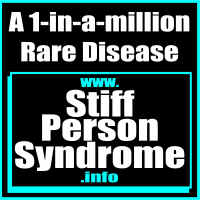Stiff person syndrome (SPS)
Stiff person syndrome (SPS) is a rare, progressive syndrome that affects the nervous system, specifically the brain and spinal cord.
Although very rare (Stiff Person Syndrome affects only 1 in a million people), McDonald & McDonald has represented several Long Term Disability Insurance clients who have suffered from SPS.
The cause of stiff person syndrome is unknown, but research suggests it is the result of an abnormal autoimmune response in the brain and spinal cord. And genetic factors involved in causing stiff person syndrome have not been established.
Symptoms
Recurrent episodes of severe muscle stiffness & rigidity
painful spasms in the trunk and limbs
Spasms can severely impair mobility & generate enough force to fracture bone.
People with SPS can experience heightened sensitivity to noise, sudden movements, and emotional distress, which can set off the muscle spasms.
Over time, symptoms can lead to an abnormal spine posture, causing the back to be hunched over.
Daily activities such as getting into or out of bed, getting up from a chair, getting dressed, or even walking without falling may become difficult
(Good News – SPS is now considered a Compassionate Allowance by the Social Security Administration)
People with SPS also may become fearful and anxious about navigating daily life, which in turn may trigger additional spasms. Many people with SPS develop depression as the syndrome progresses and quality of life becomes severely impaired
Diagnosis
SPS may be diagnosed after having various tests blood tests (including a test showing elevated glutamic acid decarboxylase (GAD) antibodies), a lumbar puncture, and electromyography
TREATMENT
Meds – Benzodiazepines, diazepam, or baclofen may be used to treat muscle stiffness and spasms. Anti-seizure medications and pain medications may also help some people.
IVIG – Intravenous immunoglobulin (IVIG) or plasmapheresis may improve some of the symptoms of SPS. For some people, autologous stem cell transplants have been shown to successfully treat SPS. Clinical trials are being completed to confirm if this may be an effective treatment.
PT or OT – Physical and occupational therapy may help to slow the progression of stiff person syndrome, but should be completed by someone who is familiar with the condition so as not to make symptoms worse.
If you need medical advice, you can look for Neurologists or other healthcare professionals who have experience with this disease or with rare progressive diseases.
John Hopkins actually has a Stiff Person Syndrome Center dedicated to helping people with this rare disease https://www.hopkinsmedicine.org/neurology_neurosurgery/centers_clinics/stiff-person-syndrome/index.html
LONG TERM DISABILITY (LTD) BENEFITS
At McDonald & McDonald, it has been our experience that LTD Insurance providers do not understand SPS. They think that because our clients may get some relief from IVIG treatment, they should be able to work.
What they fail to see is that the IVIG treatment adds to the time our clients are unable to work. When the immunoglobulin starts running low in the body, our clients have had trouble functioning until the next treatment.
The treatment itself can last 1 day to several days, and post-treatment our clients have experienced several more days of nausea, fatigue, headaches, and feeling terrible while the body adjusts .
Depending on severity, treatment may be required monthly or every two months. No employer will allow an employee to miss 7-10 days of work every month or two!
Has Your LTD Insurance Benefit been denied for Stiff Person Syndrome?
If you have SPS and your disability insurance claim has been denied,
call 1-866-242-2451 today for a free consultation.

